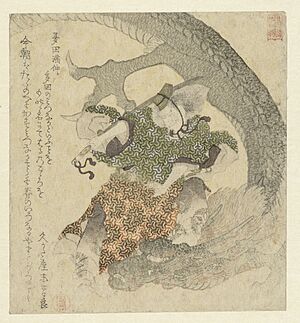Minamoto no Mitsunaka facts for kids
Minamoto no Mitsunaka (born April 29, 912 – died October 6, 997) was an important Japanese samurai and government official during the Heian period. He held powerful roles like Chinjufu-shōgun (a military commander) and acting governor of Settsu Province. Because he worked closely with the powerful Fujiwara clan, he became one of the richest and most influential people at court during his time.
Contents
Life Story
Mitsunaka was born on April 29, 912. His birth name was Myoomaru, and his father was Minamoto no Tsunemoto. He belonged to the Seiwa Genji branch of the Minamoto clan, which was a famous family that could trace its history back to Emperor Seiwa.
Mitsunaka was very loyal to several leaders of the Fujiwara clan, who were like regents (people who ruled for the Emperor). One of these leaders was Fujiwara no Morotada. There's a story about an event in 969 called the Anna Plot. Mitsunaka claimed that another important person, Minamoto no Takaakira, was planning something against the Emperor. Some historians believe Mitsunaka's warning stopped a real threat. Others think the whole thing was set up to remove Takaakira, who was a rival to Morotada. Either way, Takaakira was removed from power, and Mitsunaka gained a lot of favor with Morotada. Later, Mitsunaka also helped Fujiwara no Kaneie gain more power for his family.
Because Mitsunaka worked so closely with the Fujiwara clan, he became very wealthy and powerful. He served as the acting governor for ten different provinces, especially Settsu. This province became the main source of his military strength and money. He also inherited his father's important title of Chinjufu-shōgun, which meant he was the Commander-in-chief of the Defense of the North. The strong connection between the Fujiwara and the Seiwa Genji families lasted for almost 200 years after Mitsunaka's death. People even called the Seiwa Genji the "teeth and claws" of the Fujiwara, meaning they were their protectors and fighters.
Mitsunaka married the daughter of Minamoto no Suguru. He had three sons: Minamoto no Yorimitsu, who became a hero in many Japanese stories; Minamoto no Yorinobu; and Minamoto no Yorichika. He also had a son who became a monk named Genken. This monk, with help from another monk named Genshin, helped Mitsunaka become a Buddhist. After becoming a Buddhist, Mitsunaka built a special hall to make up for his past actions. This hall was the beginning of what is now known as Tada Temple.
In his later years, Mitsunaka moved to his home in Tada, a town in Settsu province. Because of this, he is also known as Tada Manjū. His family members who came after him are sometimes called the "Settsu Genji" or the "Tada Genji." In 987, Mitsunaka became a Buddhist monk, along with 16 of his followers and 30 court ladies. He was given the Buddhist name Mankei.
Legends and Stories
There is a famous story about Minamoto no Mitsunaka. One day, while he was hunting in his land in Settsu Province, he fell asleep under a tree. In his dream, a beautiful woman named Longnü appeared. She asked him to save her land from a giant snake that was causing trouble. Mitsunaka agreed to help, and the woman gave him a magnificent horse. When he woke up, the horse was really there! He rode the horse to the Sumiyoshi temple, where he prayed for eight days. Then, he faced the giant snake and defeated it with an arrow.
Family
- Father: Chinjufu-shōgun Minamoto no Tsunemoto
- Mother: Daughter of Tachibana no Shigefuru or daughter of Fujiwara no Toshiyuki
- Children:
- Minamoto no Yorimitsu
- Minamoto no Yorinobu
- Minamoto no Yorichika
See Also
- Yuki-onna Monogatari
- Heike Tsuruginomaki



